-

新人教版高中英语选修2Unit 3 Reading for writing教学设计
The theme of this part is to write an article about healthy diet. Through reading and writing activities, students can accumulate knowledge about healthy diet, deepen their understanding of the theme of healthy diet, and reflect on their own eating habits. This text describes the basic principles of healthy diet. The author uses data analysis, definition, comparison, examples and other methods. It also provides a demonstration of the use of conjunctions, which provides important information reference for students to complete the next collaborative task, writing skills, vivid language materials and expressions.1. Teach Ss to learn and skillfully use the new words learned from the text.2. Develop students’ ability to understand, extract and summarize information.3. Guide students to understand the theme of healthy diet and reflect on their own eating habits.4. To guide students to analyze and understand the reading discourse from the aspects of theme content, writing structure, language expression, etc., 5. Enable Ss to write in combination with relevant topics and opinions, and to talk about their eating habits.1. Guide students to analyze and understand the reading discourse from the aspects of theme content, writing structure, language expression, etc.2. Enable them to write in combination with relevant topics and opinions, and to talk about their eating habits.3. Guide the students to use the cohesive words correctly, strengthen the textual cohesion, and make the expression fluent and the thinking clear.Step1: Warming upbrainstorm some healthy eating habits.1.Eat slowly.2.Don’t eat too much fat or sugar.3.Eat healthy food.4.Have a balanced diet.Step2: Read the passage and then sum up the main idea of each paragraph.

新人教版高中英语选修2Unit 3 Using langauge-Listening教学设计
1. How is Hunan cuisine somewhat different from Sichuan cuisine?The heat in Sichuan cuisine comes from chilies and Sichuan peppercorns. Human cuisine is often hotter and the heat comes from just chilies.2.What are the reasons why Hunan people like spicy food?Because they are a bold people. But many Chinese people think that hot food helps them overcome the effects of rainy or wet weather.3.Why do so many people love steamed fish head covered with chilies?People love it because the meat is quite tender and there are very few small bones.4.Why does Tingting recommend bridge tofu instead of dry pot duck with golden buns?Because bridge tofu has a lighter taste.5 .Why is red braised pork the most famous dish?Because Chairman Mao was from Hunan, and this was his favorite food.Step 5: Instruct students to make a short presentation to the class about your choice. Use the example and useful phrases below to help them.? In groups of three, discuss what types of restaurant you would like to take a foreign visitor to, and why. Then take turns role-playing taking your foreign guest to the restaurant you have chosen. One of you should act as the foreign guest, one as the Chinese host, and one as the waiter or waitress. You may start like this:? EXAMPLE? A: I really love spicy food, so what dish would you recommend?? B: I suggest Mapo tofu.? A: Really ? what's that?

新人教版高中英语选修2Unit 4 Learning about Language教学设计
This section guides students to pay attention to the typical context of vocabulary use, helps students accumulate vocabulary around the key vocabulary of this unit, and uses the learned words and word chunks in different contexts to deeply understand their meaning and usage, so as to achieve the purpose of review and consolidation.The teaching design activities aim to guide students to pay attention to the typical context in which the target vocabulary is used, as well as the common vocabulary used in collocation, so that students can complete the sentence with correct words. In terms of vocabulary learning strategies, this unit focuses on cultivating students' ability to pay attention to collocation of words and to use word blocks to express meaning.For vocabulary learning, it is not enough just to know the meaning of a single word, but the most important thing is to master the common collocations of words, namely word blocks.Teachers should timely guide students to summarize common vocabulary collocation, such as verb and noun collocation, verb and preposition collocation, preposition and noun collocation, and so on.1. Guide students to understand and consolidate the meaning and usage of the vocabulary in the context, 2. Guide the students to use the unit topic vocabulary in a richer context3. Let the students sort out and accumulate the accumulated vocabulary, establishes the semantic connection between the vocabulary,4. Enable students to understand and master the vocabulary more effectivelyGuiding the Ss to use unit topic words and the sentence patterns in a richer context.

新人教版高中英语选修2Unit 4 Reading for writing教学设计
假定你是英国的Jack,打算来中国旅行,请你给你的中国笔友李华写一封信,要点如下:1.你的旅行计划:北京→泰山→杭州;2.征求建议并询问他是否愿意充当你的导游。注意:1.词数80左右(开头和结尾已给出,不计入总词数);2.可以适当增加细节,以使行文连贯。参考词汇:故宫 the Forbidden City;泰山 Mount TaiDear Li Hua,I'm glad to tell you that 'm going to visit China.First,I am planning to visit Beijing,the capitalof China,where I am looking forward to enjoying the Great Wall,the Forbidden City and somebeautiful parks.Then I intend to go to visit Mount Tai in Shandong Province.I've heard that it is one ofthe most famous mountains in China and I can't wait to enjoy the amazing sunrise there.After that,I amalso going to Hangzhou.It is said that it is a beautiful modern city with breathtaking natural sights,among which the West Lake is a well- known tourist attraction.What do you think of my travel plan? Will you act as my guide? Hope to hear from you soon.

新人教版高中英语选修2Unit 4 Using langauge-Listening教学设计
The theme of the listening section is " talking about scenery and culture along a journey."The part is designed to further lead the students to understand Canadian natural geography and social environment, and integrated into the cultural contrast by mentioning the long train journey from Beijing to Moscow routes. On this basis, the part activates students related travel experience, lets the student serial dialogue, guides the student to explore further the pleasure and meaning of the long journey, and Chinese and foreign cultural comparison.The part also provides a framework for the continuation of the dialogue, which is designed to provide a framework for students to successfully complete their oral expressions, and to incorporate an important trading strategy to end the dialogue naturally.1. Help students to understand and master some common English idioms in the context, and experience the expression effect of English idioms.2. Guide the students to understand the identity of different people in the listening context, and finish the dialogue according to their own experience.3. Instruct the students to use appropriate language to express surprise and curiosity about space and place in the dialogue, and master the oral strategy of ending the dialogue naturally.1. Instruct students to grasp the key information and important details of the dialogue.2. Instruct students to conduct a similar talk on the relevant topic.

新人教版高中英语选修2Unit 5 Learning about Language教学设计
The purpose of this section of vocabulary exercises is to consolidate the key words in the first part of the reading text, let the students write the words according to the English definition, and focus on the detection of the meaning and spelling of the new words. The teaching design includes use English definition to explain words, which is conducive to improving students' interest in vocabulary learning, cultivating their sense of English language and thinking in English, and making students willing to use this method to better grasp the meaning of words, expand their vocabulary, and improve their ability of vocabulary application. Besides, the design offers more context including sentences and short passage for students to practice words flexibly.1. Guide students to understand and consolidate the meaning and usage of the vocabulary in the context, 2. Guide the students to use the unit topic vocabulary in a richer context3. Let the students sort out and accumulate the accumulated vocabulary, establishes the semantic connection between the vocabulary,4. Enable students to understand and master the vocabulary more effectivelyGuiding the Ss to use unit topic words and the sentence patterns in a richer context.Step1: Read the passage about chemical burns and fill in the blanks with the correct forms of the words in the box.

新人教版高中英语选修2Unit 5 Reading and thinking教学设计
The theme of this activity is to learn the first aid knowledge of burns. Burns is common in life, but there are some misunderstandings in manual treatment. This activity provides students with correct first aid methods, so as not to take them for granted in an emergency. This section guides students to analyze the causes of scald and help students avoid such things. From the perspective of text structure and collaborative features, the text is expository. Expository, with explanation as the main way of expression, transmits knowledge and information to readers by analyzing concepts and elaborating examples. This text arranges the information in logical order, clearly presents three parts of the content through the subtitle, accurately describes the causes, types, characteristics and first aid measures of burns, and some paragraphs use topic sentences to summarize the main idea, and the level is very clear.1. Guide students to understand the causes, types, characteristics and first aid methods of burns, through reading2. Enhance students’ ability to deal withburnss and their awareness of burns prevention3. Enable students to improve the ability to judge the types of texts accurately and to master the characteristics and writing techniques of expository texts.Guide students to understand the causes, types, characteristics and first aid methods of burns, through readingStep1: Lead in by discussing the related topic:1. What first-aid techniques do you know of ?CPR; mouth to mouth artificial respiration; the Heimlich Manoeuvre

新人教版高中英语选修2Unit 5 Using langauge-Listening教学设计
The theme of this section is to learn how to make emergency calls. Students should learn how to make emergency calls not only in China, but also in foreign countries in English, so that they can be prepared for future situations outside the home.The emergency telephone number is a vital hotline, which should be the most clear, rapid and effective communication with the acute operator.This section helps students to understand the emergency calls in some countries and the precautions for making emergency calls. Through the study of this section, students can accumulate common expressions and sentence patterns in this context. 1.Help students accumulate emergency telephone numbers in different countries and learn more about first aid2.Guide the students to understand the contents and instructions of the telephone, grasp the characteristics of the emergency telephone and the requirements of the emergency telephone.3.Guide students to understand the first aid instructions of the operators.4.Enable Ss to make simulated emergency calls with their partners in the language they have learned1. Instruct students to grasp the key information and important details of the dialogue.2. Instruct students to conduct a similar talk on the relevant topic.Step1:Look and discuss:Match the pictures below to the medical emergencies, and then discuss the questions in groups.
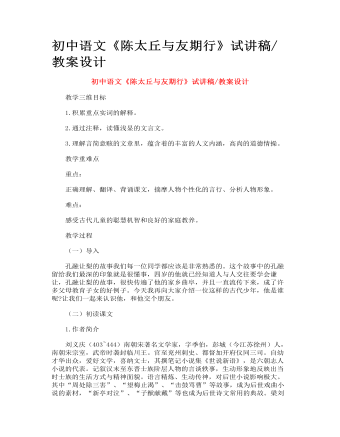
初中语文《陈太丘与友期行》试讲稿_教案设计
刘义庆(403~444)南朝宋著名文学家,字季伯,彭城(今江苏徐州)人,南朝宋宗室,武帝时袭封临川王。官至兖州刺史、都督加开府仪同三司。自幼才华出众,爱好文学,喜纳文士,其撰笔记小说集《世说新语》,是六朝志人小说的代表。记叙汉末至东晋士族阶层人物的言谈轶事,生动形象地反映出当时士族的生活方式与精神面貌。语言精炼、生动传神,对后世小说影响极大。其中“周处除三害”、“望梅止渴”、“击鼓骂曹”等故事,成为后世戏曲小说的素材,“新亭对泣”、“子猷献戴”等也成为后世诗文常用的典故。梁刘孝标作注,旁征博引,为后人所重。另有《幽明录》,今佚。鲁迅《古小说钩沉》辑其佚文200余条,皆记诡异之事。
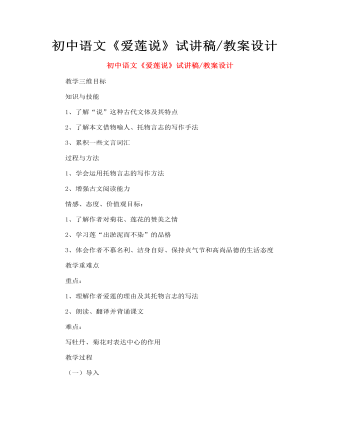
初中语文《爱莲说》试讲稿_教案设计
初读课文 了解文体,熟悉作者 文章的题目是《爱莲说》“爱”表现了作者的感情,“莲”是这篇文章写作的主体,“说” 在这里指什么? 明确:“说”是一种文体,可以说明事物,也可以发表议论或记叙事物 “说”这种文体可以灵活地运用说明、记叙和议论的表达方式,偏重于议论那么题目的意思是什么呢?可以理解为“谈谈爱莲花的道理”或“说说喜爱莲花的道理” 他爱莲花有什么道理呢?大家在学习课文中一定要开动小脑筋 本文作者周敦颐 ,(10171073) ,宋代道洲(现在湖南省道县)人,字茂叔,哲学家因他世居道县濂溪,后居庐山莲花峰前,峰下有溪,也命名为濂溪,学者就称他为“濂溪先生”
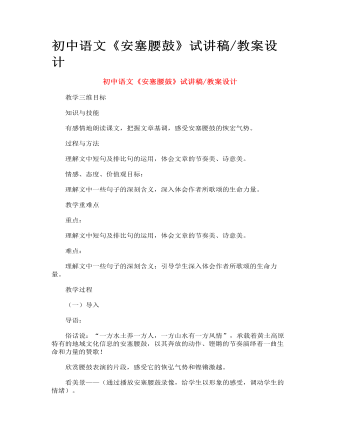
初中语文《安塞腰鼓》试讲稿_教案设计
精读课本,贯通全文 提问:整篇文章极富震撼力,文章中一个排比接一个排比,一个高潮连一个高潮,大家从中体味到了什么? 明确: A、这是一篇歌颂激荡的生命和磅礴的力量的文章。 B、全文洋溢着一种阳刚之美。 C、表现要冲破束缚、阻碍的强烈渴望。 朗读赏析探究 赏美图,配佳句——为了让大家对被誉为“天下第一鼓”的安塞腰鼓有更直观的认识,我们再来看几组特写照片。看后请各小组用课文中的文句与之相配并高声朗读。 明确:对排比句进行总结,说出对句子的理解。 怎样理解“耳畔是一声渺远的鸡声”? ①鸡啼预示天明,是新的一天的开始,是希望的象征。 ②这是以声衬静,用鸡啼反衬火烈的鼓声停止后大地的寂静。 说美点,品美韵——这篇文章美吗?美在哪里? 语言美: 课文多用短句来表现内容;大量运用排比,有句内、句与句、段与段之间的排比,交错出现,连用许多。
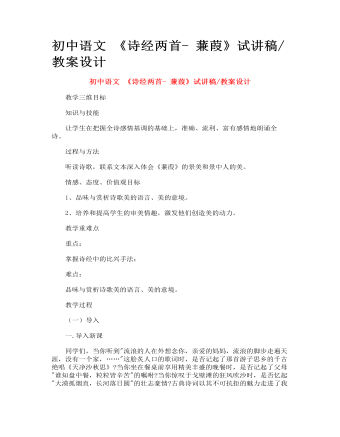
初中语文 《诗经两首- 蒹葭》试讲稿_教案设计
同学们,当你听到"流浪的人在外想念你,亲爱的妈妈,流浪的脚步走遍天涯,没有一个家,……"这脍炙人口的歌词时,是否记起了那首游子思乡的千古绝唱《天净沙秋思》?当你坐在餐桌前享用精美丰盛的晚餐时,是否记起了父母"谁知盘中餐,粒粒皆辛苦"的嘱咐?当你惊叹于戈壁滩的狂风吹沙时,是否忆起"大漠孤烟直,长河落日圆"的壮志豪情?古典诗词以其不可抗拒的魅力走进了我们的生活,为我们的生活增添了更多的美丽与奇妙。今天,让我们一起学习《蒹葭》这首诗歌,再一次用诗歌滋润我们渴求的心灵。
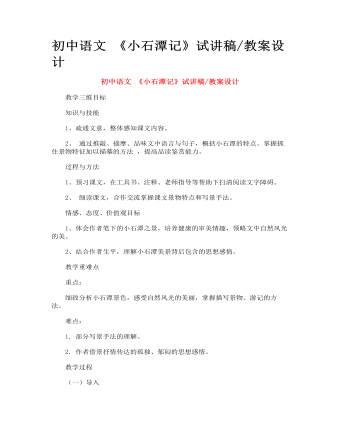
初中语文 《小石潭记》试讲稿_教案设计
大家都知道,在中国文学史上有不少的文人用他们的笔墨描写过优美的山水,比如说我们以前学过: 唐 杜牧《江南春》: 千里莺啼绿映红,水村山郭酒旗风。南朝四百八十寺,多少楼台烟雨中。 杜甫《望岳》:岱宗夫如何? 齐鲁青未了。造化钟神秀,阴阳割昏晓。 荡胸生层云, 决眦入归鸟。 会当凌绝顶, 一览众山小。 郦道元在《三峡》中也有“春冬之时,则素湍绿潭,回清倒影。”这样引人入胜的景色。可以说优美的山水诗文不可枚举,那么今天让我们跟随柳宗元一起走进小石潭,看看又是怎样的一幅山水画呢?他又是怎样的心情写下这篇游记的呢?
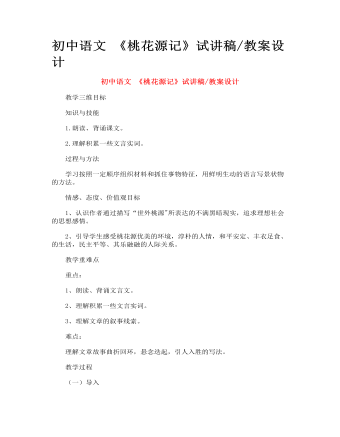
初中语文 《桃花源记》试讲稿_教案设计
陶渊明生于东晋末朝,出身于没落的地主官僚家庭。他少时颇有壮志,博学能文,任性不羁。当时社会动乱不安,他有志不得展。做过小官,由于不满官场的丑恶,弃官回乡,这时他四十一岁,从此过着“躬耕自资”的隐居生活。忧愤、饥寒、劳累、赢疾一起折磨着他,六十三岁去世。后称靖节先生。他所作的诗文,内容多描写农村生活,表现了优美的自然风光,抒发他热爱田园生活、乐于和农民来往和不愿与统治者同流合污的高尚感情;但也包含了乐天知命、消极适世的因素。在形式上一反当时华而不实的文风,明朗清新,质朴自然,善于抓住客观事物最突出的特征,淡淡几笔传神的表现它的形象,简洁含蓄而富有韵味,对后代作家有较大的影响。本文写作年代大约是宋永初二年(421年),其时陶渊明已经五十七岁了。他拒绝同刘格的来政权合作,不满黑暗的政治现实,同时由于他和农民接近,理解他们追求理想社会的愿望,所以写了这篇记和诗。

新人教版高中英语选修2Unit 2 Bridging Cultures-Discovering useful structures教学设计
The grammar of this unit is designed to review noun clauses. Sentences that use nouns in a sentence are called noun clauses. Nominal clauses can act as subject, object, predicate, appositive and other components in compound sentences. According to the above-mentioned different grammatical functions, nominal clauses are divided into subject clause, object clause, predicate clause and appositive clause. In this unit, we will review the three kinds of nominal clauses. Appositive clauses are not required to be mastered in the optional compulsory stage, so they are not involved.1. Guide the students to judge the compound sentences and determine the composition of the clauses in the sentence.2. Instruct students to try to learn grammar by generalizing grammar rules, controlling written practice, and semi-open oral output.3. Inspire the students to systematize the function and usage of noun clause1.Instruct students to try to learn grammar by generalizing grammar rules, controlling written practice, and semi-open oral output.2.Inspire the students to systematize the function and usage of noun clauseStep1: The teacher ask studetns to find out more nominal clauses from the reading passage and udnerline the nominal clauses.
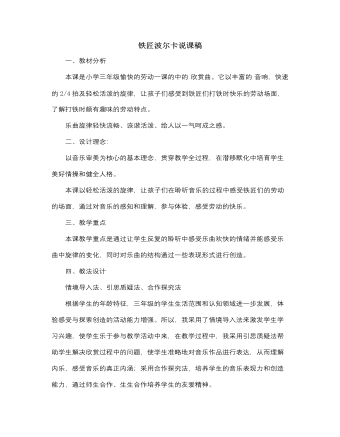
人音版小学音乐一年级下铁匠波尔卡说课稿
接受能力强的学生分为一组,让他们互相监督自己练习;接受能力弱的学生分为一组,老师进行个别教育。 通过分组教学得到因材施教的作用。(用传统的跟学法让学生直观地学会边歌曲边表演动作。通过分组教学得到因材施教和学生自主学习的效果。)(四)师生一起边唱边跳互动表演。(通过尽情的表演让学生张扬个性,满足孩子的表演欲望。)(五)课后作业:课后练习边唱《粉刷匠》边跳舞。(让学生学习的内容得到巩固。)(六)课堂延伸和总结 小粉刷匠热爱劳动,不怕脏不拍累,小朋友们向他学习,在学校要主动打扫卫生,在家要积极做自己力所能及的家务活,做一个爱劳动的好孩子。 (延伸课堂内容,提高教学效果。)总之,在这些活动中,更重要的是我们的学生能通过自身的感受、体验而获得情感审美上的升华,提高他们的动作协调性,为热爱音乐、热爱艺术、热爱生活打下良好基础。
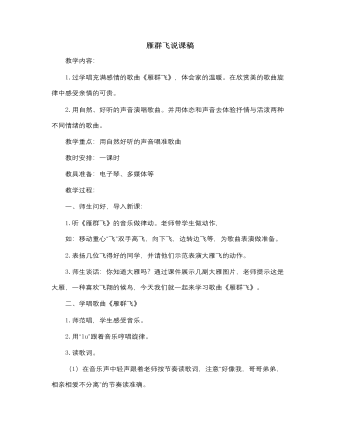
人音版小学音乐一年级下雁群飞说课稿
(1)在音乐声中轻声跟着老师按节奏读歌词,注意“好像我,哥哥弟弟,相亲相爱不分离”的节奏读准确。(2)老师读上半句,学生读下半句。4.逐句教唱,解决难点乐句“飞来飞去不分离”。5.找出旋律相同的两句,用不同的图形或字母表示出来,如:ABA。6.《雁群飞》是一首优美抒情的歌曲,应该用什么样的声音和感情演唱歌曲呢?学生说一说,有感情的演唱歌曲。7.分小组进行简单的动作创编,注意表现出歌曲中的相同与不同。8.学生表演。9.教师与学生一起评一评。三、教师小结。教后记:为了能让学生理解到歌曲的结构,我设问,“歌曲中哪些地方是重复的?”学生经过老师的引导,用笔勾画出了歌曲中重复的乐句。这时我形象地比喻道,它的结构有点像我哦们吃的“肉夹馍”,两边是馍中间有一块好吃的肉,学生一下哈哈大笑起来,还不时地回味说,“真像‘肉夹馍’。”听到这样的回答,我想学生一定对歌曲的结构有了清晰的认识。
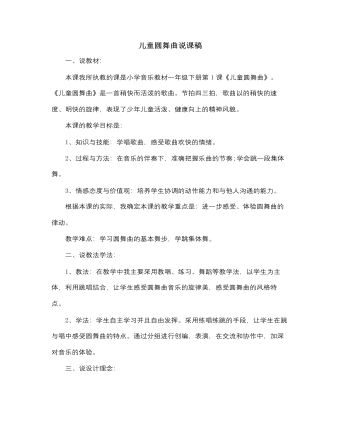
人音版小学音乐一年级下儿童圆舞曲说课稿
本课我采用欣赏《杜鹃圆舞曲》的片断导入新课,挖掘学生已有的对圆舞曲特点的了解,让学生快速进入学习情境,增加学生对圆舞曲学习的兴趣。导入完新课以后,我遵循音乐是听觉的艺术,从聆听入手学唱歌曲,第一次听录音的范唱,让学生聆听音乐,了解歌词的内容。第二次教师有感情的演唱,激发学生听的兴趣,加深学生对歌曲的节拍情绪的理解和感受。在歌曲旋律唱会后,学生自然地就能演唱这首歌曲,知识技能的掌握渗透在歌曲学唱之中。让学生在轻松愉悦的氛围中短时高效的学会歌曲。为了开发学生的创造性潜智,在学会歌曲以后,我设计了舞蹈创编这个教学环节。舞蹈创编就是学生对音乐的再度创作,是发挥学生想象力和思维潜能的学习领域,是学生积累音乐创作经验和发掘创造思维能力的过程和手段,对于培养具有实践能力的创新人才,具有十分重要的意义。让学生的身心、肢体与音乐密切结合,让学生在创编合作中体验快乐,表现快乐。
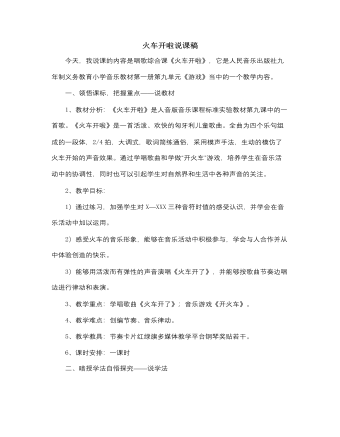
人音版小学音乐一年级下火车开啦说课稿
6、你言我语尽情唱游开火车的唱游对于学生来说是没有什么难度的,我不想手把手的教,而是想让孩子自己摸索出开好火车的方法,于是我说“想把火车开好可不是一件容易的事情,因为火车有好多车厢连在一起,怎么把它连起来?怎么开,我们一起来商量一下。学生有很多方法有的建议拉着前面同学的衣服、搭着前面同学肩膀,我让学生跟我一起来演示,一起研究,大家一起决定什么动作比较好。最后,师生都认同右手搭在前面同学肩膀,左手做车轮滚动的样子。就这样,一列列小火车很快就能够上路了。在唱游过程中,学生不可避免的是相互碰撞,这时停下音乐,宣布:“现在发生了交通意外,请各辆小火车赶快回到自己的位置。”一起讨论怎样才能安全行驶,相互不让路,不喧哗。7、开动火车乐趣无限唱游结束后,我安排了一个游戏:音乐中,两列小火车在教室里自由行驶,音乐停下时到站请旅客上车,音乐开始后继续旅行,直到所有的乘客都上车。这个游戏的设计也是为了让学生体会共同游戏的乐趣,在游戏中学会礼让,安全驾驶。
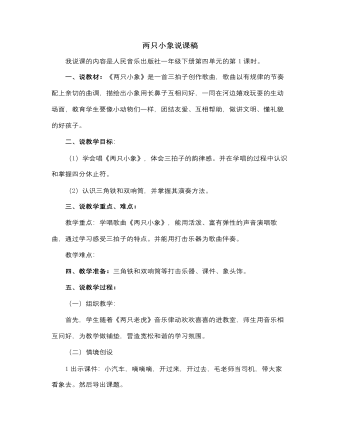
人音版小学音乐一年级下两只小象说课稿
又能再次让学生体会三拍子的韵律感。在配打击乐器为歌曲伴奏这个环节我通过“看图片、找乐器、读节奏、选节奏、敲乐器”等活动充分调动学生学习的积极性,再次掀起学生们的学习乐趣。五、总结:今天我们在动物园和小动物们度过了愉快的一天,我们应爱护小动物,和它们做朋友,而且更要像小动物们一样,团结友爱、互相帮助,做懂礼貌的好孩子。并预告下节课将做象头饰及分小组比赛表演。(在《两只小象》音乐中律动出教室。)总体来说,本方案的设计利用多媒体为学生创设一种生动、直观的教学情景,通过看、听、唱、舞等手段,充分调动了学生的兴趣和积极性,同时在各种音乐活动中,充分体现了学生自主、合作、探究的学习方式,使学生会学、乐学、敢学,将学生自主学习与创新意识的培养落到了实处.

